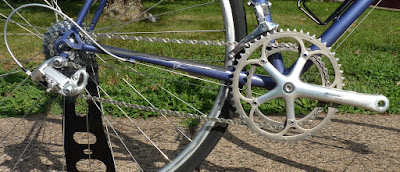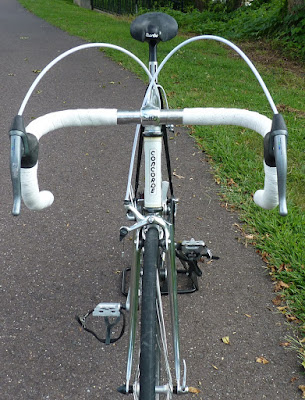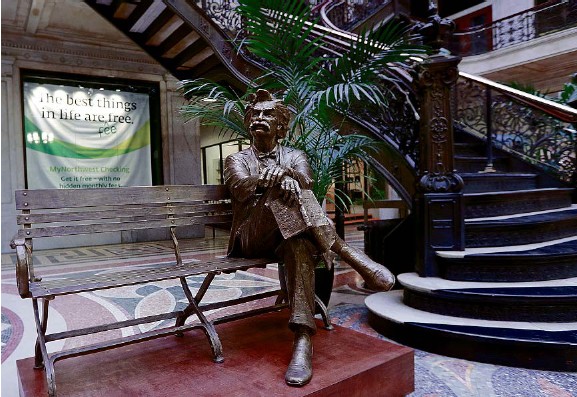 It has been a quite a while (March?!!) since
I have written about bicycle projects, as I was
It has been a quite a while (March?!!) since
I have written about bicycle projects, as I was
Now it's time to get busy back in the shop. There
has been quite a bit of progress during the past couple of weeks we have been
home. A nice pile of parts had been on hold at the post office, and
I had a decent amount of work just unpackaging everything.
Just before we left for Michigan, a new
friend and fellow Lehigh Valley native named James had dropped off a 1987
Schwinn Prelude that he wanted to pass onto his son. This bicycle was produced
before Schwinn went the Walmart, off-the-shelf route of cheaply made and
outfitted bicycles. James’ Prelude had Columbus Tenax tubing, which may not be at
the level of SLX or even Cromor tubes, but it is quality stuff, certainly at
the price point at which you’ll find a Schwinn!
The bike was set up with a mix of new and
old Shimano components, including downtube shifters, and a Sakae crankset.
James’ wish was to convert the bike to a more modern Campagnolo group with Ergo
shifters, and I had a nice Chorus 8-speed group on my shelf, which fit the bill
perfectly. The bike had 126mm rear spacing, so a bit of cold setting was needed
in order to fit set of freehub-equipped Campy Melbourne 56 wheels.
James stopped by the other day to pick up
the Prelude and brought along his Schwinn Super Sport (also of the quality era) to switch out some parts. It wasn’t
quite “Bicycle University”, as he had a good base of knowledge compared to some
of my previous students/guests, but he tried his hand at some of the work and
provided some great conversation during the afternoon of tinkering.
Before our vacation, I had also squeezed in
a trip to North Jersey to pick up a donor bicycle for the Casati Fibra build.
Lately I’m finding the donor route to be the more affordable way to go for
higher-end parts, especially when purchasing through craigslist. EBay
unfortunately started charging sales tax on Pennsylvania buyers, and when
picking up bicycles and component groups for a few hundred dollars, that extra
6-8% on the bill is not fun at all.
I met a guy named Anthony, who was a bit of
a collector of everything, especially automobiles and related parts. He had
picked up a solid Univega frameset made of Columbus Thron tubing and put some
really nice Campagnolo Record parts on it – frankly, the desirability of the
frame brand didn’t match that of the excellent parts, and he had no takers.
This was perfect situation for me, as I knew
the value of the components alone, and with the willingness to disassemble the
bike, I would stand to make a little money back from selling the parts I wouldn’t
need. The frame is in really nice shape for a 2001 model, and someone should
pick it up as a base for an inexpensive project bike of their own.
The Olmo Sportsman should be wrapped up in
the next few days, as I’ve finally collected all the needed parts, including a
missing cable guide that I had overlooked – or maybe that’s the wrong term,
since it is under the bottom bracket, which is why I didn’t notice. I
was all set to run the cables to the derailleurs, only to be frustrated by the
delay in ordering the part. It will be in the next blog entry FOR SURE!
A new project I’m looking forward to is a
1990 Bottechia 989 Comp, painted for the Malvor-Sidi-Bottecchia pro team of
that season. The frame is similar to another Bottecchia I had built up a few years ago, in that it has all the sponsor logos on the stays, so that I have a guide
to which components to use. In this case, it will be Shimano Dura-Ace, ITM,
Selle Italia and Michelin.
Another endeavor is the assembly of a
mid-1990s Patelli bicycle that was shipped to me from a gentleman who lives just
down the street from the company’s factory in Bologna. In fact, he shipped me a
set of decals purchased at the company store, including the bag (see blog intro photo) in which he
brought the decals home!
The decals are of the water-slide variety (like
you would apply to a plastic model) and would require a clear coat over top for
protection. I really didn’t want to be bothered with that, so I purchased a
modern vinyl set instead. The frame is shiny, unpainted Columbus Thronic tubing,
which I assume is the same as the Thron tubing with which am so familiar – only
guessing here, but the word “custom” on the label might provide a clue towards
what difference there might be, plus the fact that this Patelli frame has tubes
with welded joints that don’t have lugs.
The bicycle came with Campagnolo gruppo
(Athena components/ Gamma wheels) and a set of ITM bars and stem. I’ve
purchased a Cinelli cockpit to swap in and will match up the ITM with the
Bottecchia 989 instead. While awaiting delivery of the parts, I applied the
Patelli decals – note the original Gomarasca bicycle shop sticker, as the
bicycle was originally purchased in the Cassina de Pecchi section of Milan!
Finally, and this one was a quick turnaround
after a long wait for shipment from a connection in the Netherlands, I completed
a small refurbish job on a 1988 Concorde Columbo, painted in the scheme of the
Dutch PDM pro team. This bicycle particularly appealed to me, since the team
was around in my formative years as a pro cycling fan, I remember stars like Sean
Kelly, Greg Lemond, Pedro Delgado, Adri van der Poel, Steven Rooks and Eric
Breukink all riding at some point for the squad that lasted from 1986-1992.
The core of the components on the bike are
Shimano 105, with a stylish 3T cockpit and some excellent Wolber “hoops” guiding
the machine through the curves. I just needed to give the bicycle a good
cleaning, replace the worn cables and housing and added a classic Selle Italia
Turbo saddle.
I am in the process of re-stocking, so there
are a few more new goodies being shipped to Royersford, which I’ll tell you all
about in the upcoming weeks.

















































